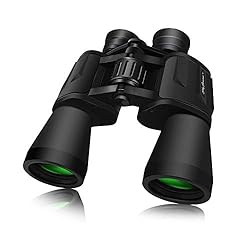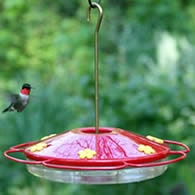Wren House - Dimensions, Hole Size, Build or Buying Information
The Wren house is one of the most common types of birdhouses in the backyard garden.
Whether you're considering buying or building, the information below will help you attract, house, and place your wren nest boxes for the best watching.
House Wrens are cavity-nesting birds and will make use of man-made wren birdhouses. Actually, Wrens will nest in just about anything.
But to give them the best chance at nesting success, we need to provide a properly constructed Wren House.
This means knowing the correct height, width, and hole size dimensions.
wild-bird-watching is an associate of Amazon.com. As such, we earn commissions from qualifying purchases at no additional cost to you.
Types of Wood Materials
Most birds are attracted to a natural-looking nest box and wood is an excellent choice.
If you plan on purchasing or building one, make sure that the wood used in constructing the house is decay-resistant wood.
Types of wood you might select are cedar, redwood, exterior plywood, or even thick recycled plastics.
Avoid purchasing any wren house that is painted dark or made of metal as they can get too hot and harm birds.
Fence boards can be used if the house is kept in the shade. The wood of fence boards is a little thin for full sun protection.
Copper arsenate has been fazed out and is only used in marine applications, so treated wood is okay to use. Check with the lumber provider to be sure.
Diameter of Hole, Floor, Size
Wrens will use a house that has an entry hole dimension of 1 1/8 inches. Any larger and house sparrows will take over and chase away or harm the wrens.
The floor should be 4 inches square and 3-6 inches below the entry hole. Measured from the bottom of the opening.
Do not add or buy any birdhouse with a perch. The birds don't need it, whereas predators will have easy access if perches are used.
The roof should be slanted to shed water and keep the contents of the nest dry. For a more traditional style, the front and back can be cut as an A-frame.
Each side should provide ventilation. Drill 1/4-inch holes on the sides of the house just under the roof.
Also, make sure there is adequate drainage in the bottom of the nesting box by drilling a 1/4-inch hole in each corner of the bottom of the wren house.
The side wall or the front of the house should slide or swing open for easy cleaning.
The plan below is a common example of a wren house, but the plan calls for a 1 by 6 by 4 inches when it should state a 1 by 6 by 4 feet, not 4 inches.
A common board of 1 inch by 6 inches by 8 feet will give you enough lumber for 2 wren houses.
In case you didn't know, the correct size of the board is 3/4-inch by 5 1/2-inch by 8 feet.
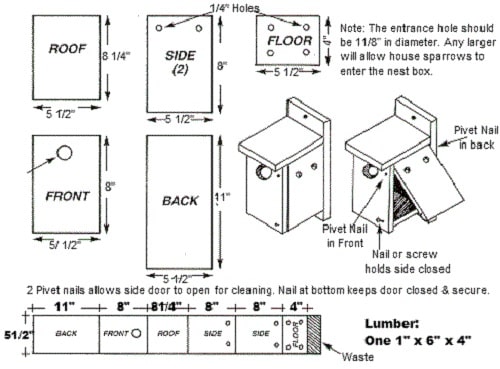
Free Wren House Plan
How High Should A Wren House Be Placed
Mount or hang the house five to ten feet high in or near a tree or shrub. House wrens seem to prefer areas with some trees and shrubs.
Place the house on an outside branch and not deep into the foliage. Heavy ground vegetation and wide open areas should be avoided.
House Wrens prefer some brushy area nearby but not surrounding the nest box.
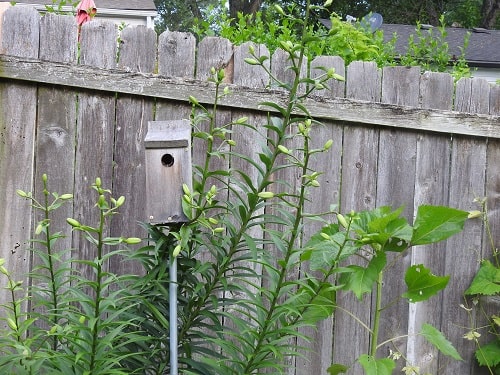
Wrens Using Bluebird House
Which Way Should Wren House Face?
Like most birdhouses, Wren Houses should be faced away from prevailing winds, which for most in the US are east, north, south, and then west would follow.
Keep in mind, birds will not read this, nor have I ever seen one with a compass. They may choose North first.
When or Should I Clean My Wren Houses?
A thorough cleaning at the end of the season or a late winter cleaning is a good idea. This cleaning will get rid of any overwintering ectoparasites.
Studies have shown that males will often remove the inner lining of the nest before renesting occurs. Sometimes, the entire nest is removed.
If the inner nest lining is heavily soiled and cemented to the rest of the nest, it may be wise to remove it by hand.
A quick check after the young fledge is all it takes to see if this is required.
Studies also show that pairs may not reuse the nest site if the male cannot remove the nest lining.
It's important to offer housing that can be cleaned. Mites and parasites can overwinter in birdhouses and harm or even kill the nestlings.
More information about our recommended Wren House can be found here: Woodlink Wren House
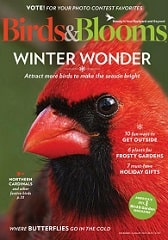
|
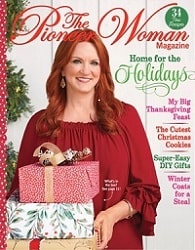
|

|

|
| Birds and Blooms | Pioneer Woman | People Magazine | First For Women |



